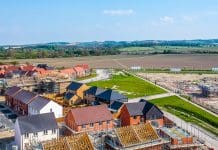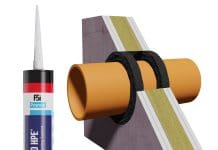Following the warmest February day ever recorded earlier in the year and 2018 being declared the fourth hottest year on record, it is clear that we need to change our ways to mitigate the impact of climate change and avoid global warming beyond 1.5C
As well as being a great insulator, durable, easy to maintain and offering a quick-build time, timber is one of the few 100% renewable building materials available making it an ideal choice for construction projects that won’t cost the earth.
Procuring timber from sustainable sources is of utmost importance to ensure the wood comes from forests that are managed in line with legal, social and environmental requirements.
Procuring sustainable timber
It is important to have a procurement policy in place to check that the timber that your company sources is legal, enforcing a preference for certified timber. This ensures that it is responsibly, lawfully and sustainably sourced.
You should also have enhanced due diligence systems in place when timber cannot be certified. The supplier you use should still be able to verify the source of the timber. It is vital that you are vigilant about the risks of illegal timber in your supply chain.
Key questions to ask
Julia Young, global forest sector transformation at WWF, offers some tips on questions to ask when procuring timber:
“All main timber merchants in the UK are capable of supplying either FSC or PEFC timber, for virtually all types of timber that you may need. They will understand why you want to specify certified timber and be able to provide an invoice with the chain of custody clearly shown.
“So check with your merchant – if they can’t readily confirm that they can fulfil your order with certified timber, then move on to another supplier who can. Once you have got your supplier – make it crystal clear on your order that you want certified timber, and for the chain of custody to be clear on the invoice.
“But remember – it is up to you to ask, and then to make sure that you get what you asked for, so that you know you are achieving compliance against your own sourcing policy and sustainability commitments.”
What’s in it for me?
It is actually against the law to buy timber which has been illegally harvested.
Since 2009, only timber which has been independently verified as being from a legal and sustainable source is permitted under the Government’s Timber Procurement Policy (TTP) for publicly funded projects. This means that if you are a construction manager or contractor working on a public sector project you must make sure that you fully comply with the procurement requirements.
The European Union also introduced the EU Timber Regulation (EUTR) in 2013 which prohibits the placing of illegally harvested timber on the European market.
Sustainable forests
Sustainably managed forests grow trees to replace the ones which are cut down. Where more trees are planted than harvested, forestation increases and helps to encourage biodiversity, maximising CO2 absorption and outweighing the emissions released through transport and felling.
To reduce deforestation and forest degradation within developing countries the United Nations has developed the Reducing Emissions from Deforestation and Forest Degradation (REDD+) programme which offers developing countries incentives while improving conservation, sustainable management of forest and enhancement of forest carbon stocks.
Forest certification systems such as the Programme for the Endorsement of Forest Certification (PEFC) and the Forest Stewardship Council (FSC) allow timber buyers to be able to identify and purchase wood from well-managed forests. Both certification bodies aim to protect biodiversity, ecosystem services, local employment, and indigenous peoples’ rights within the forest through sustainable management.
Effective weapon against climate change
Increasing forest cover is one of the most effective weapons in the battle against climate change. According to The International Union for Conservation of Nature (IUCN), forests help to stabilise the climate, regulate ecosystems, protect biodiversity and help drive sustainable growth. Scientists have said that by protecting and restoring forests, there would be a global emissions reduction of 18% by 2030.
With many areas of the UK prone to flooding, a report from the Forestry Commission shows that increased forest cover also assists with water retention, a natural way to combat flooding and another way to mitigate climate change.
The creation of more woodland can also help with the quest for clean water. A number of water companies in the UK are looking into purification schemes where forest cover could help diffuse water pollution.
Twitter: @Wood_for_Good
LinkedIn: Wood for Good







![[VIDEO] GBC network calls for boldness at COP29 Baku, Azerbaijan, where COP29 will take place and where the GBC Network have deirected their message](https://www.pbctoday.co.uk/news/wp-content/uploads/2024/11/iStock-513054348-1-218x150.jpg)






